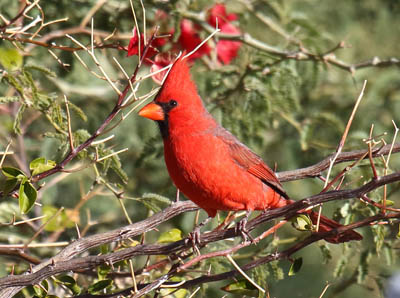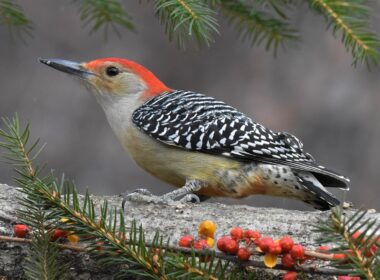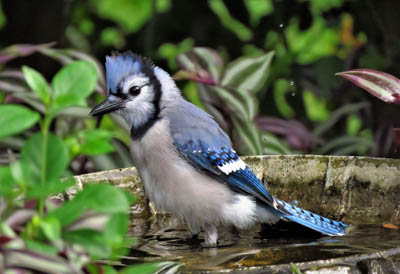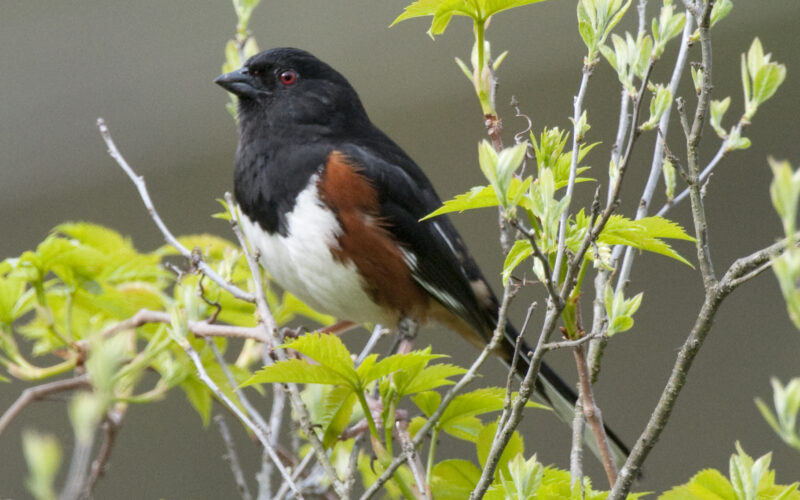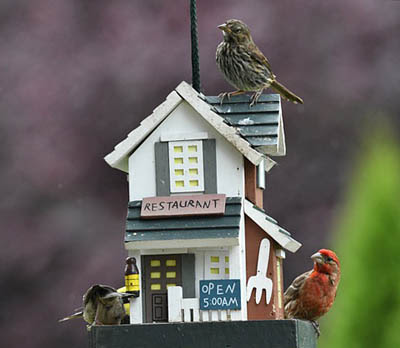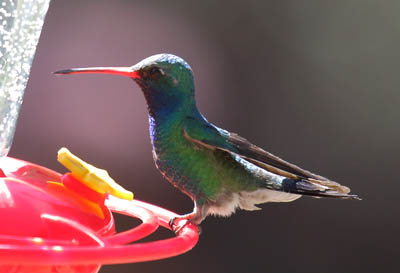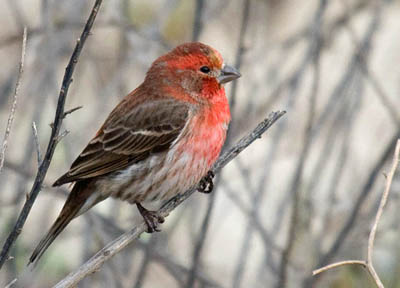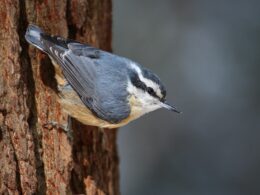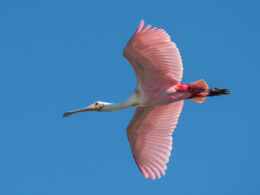Last Updated on January 21, 2024 by Greg Gillson
Are you planning on setting up a bird feeder and feeding winter birds in Alabama?
Are you looking for new ideas on what to feed birds this winter?
Do you wonder what birds come to feeders in Alabama in winter?
Wonderful! This article is for you!
This article tells why and how to set up a bird feeder in Alabama in the winter. I’ll also show you photos of the common feeder birds in Alabama that you can look for at your own backyard feeder! I will give brief identification tips. I will tell you what foods and what type of feeders attract each species.
Why feed winter birds in Alabama?
Winters are mild to cool and rainy in Alabama. It drops below freezing occasionally at night.
These milder temperatures mean that the birds do not really need us to feed them in order for them to survive.
However, the birds certainly will take advantage of any foods we offer.
And, at the southern edge of the United States, many birds spend the winter here that summer farther north. They will appreciate a steady supply of feed at your feeders over winter. Then they can fatten up before they migrate back north in the spring.
Birds are one of the best and easiest ways to connect with nature. This brings joy into your life. Seeing colorful and active birds on those dreary winter days will certainly cheer you up!
Bird watching at your feeders can be a social past-time, too. Many of your friends and neighbors no doubt feed birds in winter, or throughout the year.
What birds come to feeders in winter in Alabama?
Many of the birds that come to your feeder in winter are year-round residents. Once you learn these common birds at your feeder, you’ll be able to immediately notice the more unusual visitors to your yard.
Of course, you can watch the birds at your feeder without learning their names. But learning a bird’s name is the first step into getting to know them better.
If you are interested, I have written an article on the common backyard birds of Alabama–not just winter, and not just the birds that come to your feeder. I’ll link to this resource again at the end of this article.
Here, then, are the birds that are most-likely to show up at your bird feeder in Alabama during the winter.
Northern Cardinal
These are well-known birds due to their bright red coloration, fairly large size, and perky crest.
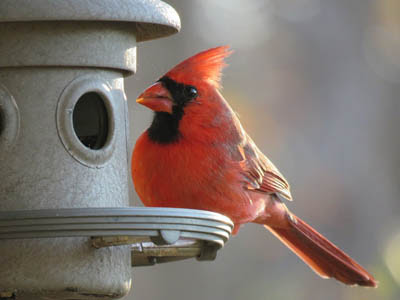 |
| Northern Cardinal. GeorgeB2 from Pixabay. |
These are year-round residents throughout the East and South.
Northern Cardinals are year-round residents throughout Alabama.
Larger than sparrows, but smaller than robins. Males are bright red, females brown. They have thick orange bills, black chin and throat, and obvious crests.
Northern Cardinals eat larger seeds, including sunflower seeds and safflower seeds from hopper and platform feeders, but often feed on the ground.
Mourning Dove
These birds are one of the most widespread in North America.
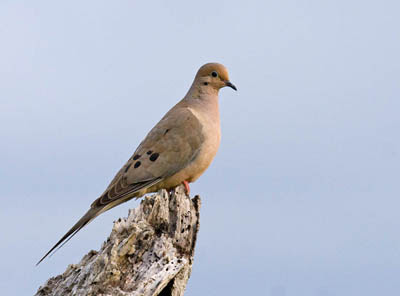 |
| Mourning Dove. Greg Gillson. |
In summer they breed in open fields, farms, prairies, towns, across all of the United States and north into Canada. In winter they depart most of Canada and the northern Great Plains and higher elevations in the northern states.
Mourning Doves are year-round residents throughout Alabama.
These plump birds have a small round head and pointed tail. They are larger than most feeder birds, but not as large as a domestic pigeon.
Mourning Doves eat mixed seeds and grains. They prefer eating on the ground or from platform feeders.
Carolina Chickadee
This cute little bird is widespread throughout the southeastern United States in deciduous forests.
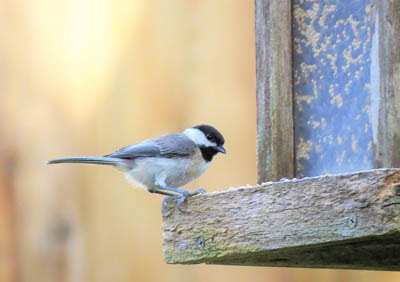 |
| Carolina Chickadee Image by George2 from Pixabay |
Carolina Chickadees are year-round residents throughout Alabama.
It gives a rapid chick-a-dee-dee-dee call and a whistled song fee-bee, fee-bay.
Gray back, wings, tail, and pale gray flanks. Black cap and throat contrasting with white face.
Carolina Chickadees like seeds, especially black oil sunflower seeds. They like suet, too. They eat from any kind of feeder.
Carolina Wren
This wren is a common resident in woodland tangles and backyards throughout the East.
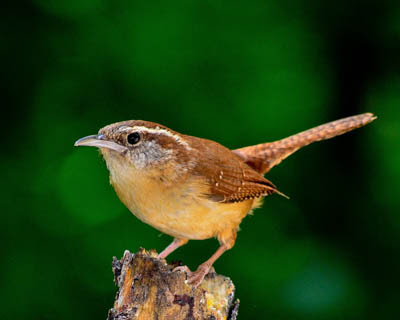 |
| Carolina Wren Image by SOARnet from Pixabay |
Carolina Chickadees are year-round residents throughout Alabama.
They sing all year, a loud musical teakettle, teakettle, teakettle or cheery cheery cheery. The call notes are loud and varied, including a chert call.
These have typical round wren bodies with short neck and long active tails. They are rich brown above, warm buffy below with a white throat and long white eyebrow strip back from the eye.
Carolina Wrens visit suet feeders.
Blue Jay
These are well-known birds, displayed in advertising and sports teams.
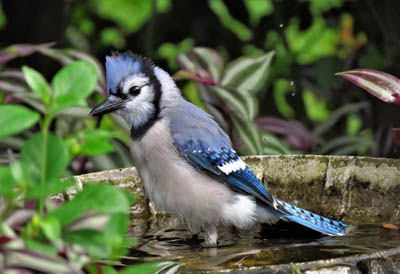 |
| Blue Jay. Skeeze from Pixabay. |
They live year-round in deciduous woods with oaks or nuts through most of the United States east of the Rocky Mountains. In summer they also migrate north well into Canada.
Blue Jays are year-round residents throughout Alabama.
These are blue above, white below and on the face, with a black necklace across the throat wrapping behind the head. The blue crest is a distinguishing mark.
Blue Jays eat sunflower seeds. They love peanuts, too. They use hopper and platform feeders.
Tufted Titmouse
These plain birds are rather common at bird feeders in the East.
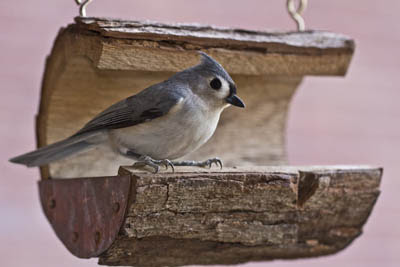 |
| Tufted Titmouse. Anne773 from Pixabay. |
These birds live year-round in deciduous woods east of the Great Plains in the United States.
Tufted Titmouses are year-round residents throughout Alabama.
Small, a bit larger than chickadees. They are plain gray with a bit of black feathers on their forehead. The crest is often inconspicuous.
Tufted Titmouses eat black oil sunflower seeds from hopper feeders. They are also fond of peanuts.
Red-bellied Woodpecker
These woodpeckers are fairly common at bird feeders in the East, especially where there are larger hardwood trees.
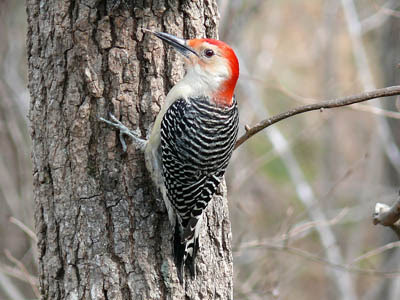 |
| Red-bellied Woodpecker. Skeeze from Pixabay. |
These birds live year-round in the United States east of the Rocky Mountains and Great Plains.
Red-bellied Woodpeckers are year-round residents throughout Alabama.
These birds cling to tree trunks. They have finely barred black-and-white backs. The head and under parts are rather pale gray. Red feathers on the back of the neck reach the bill on males.
Red-bellied Woodpeckers love peanuts from platform feeders. They also eat sunflower seeds and suet.
Yellow-rumped Warbler
Watch your suet feeders or bushes with berries for these birds in winter.
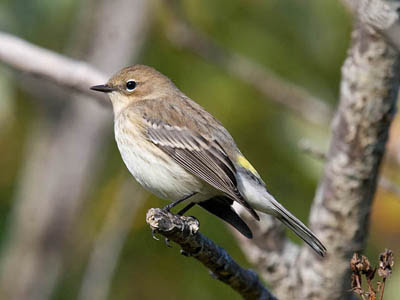 |
| Yellow-rumped Warbler Photo by Greg Gillson |
These abundant warblers nest in conifer and mixed forests across Alaska and Canada and in the mountains of the northeastern United States and the West. They winter along both Atlantic and Pacific coasts of the Unites States and across the southern states into Mexico.
Yellow-rumped Warblers are winter visitors throughout Alabama.
In summer they are very bright. The upper parts are bluish and they have a black chest. They have a yellow crown patch. Western birds have a yellow throat and large white wing patch. Eastern birds have white throat and two white wing bars.
In winter they are very dull. But, summer or winter, they flash white tail corners in flight and have a bright yellow rump.
They have a complicated slow warble ending in a trill. Their call note is a flat tchep.
While you may see Yellow-rumped Warblers crawling through leafy foliage gleaning insects, or flying out to snatch bugs out of the air, they will come to your feeder if you offer suet.
Eastern Bluebird
If you have some open farmlands adjacent to your home, you may attract Eastern Bluebirds to your backyard. If so, you’ll want to set up some bird houses in summer.
 |
| Eastern Bluebird. Image by skeeze from Pixabay. |
These birds are found in orchards adjacent to open fields and pastures. They may be found in open pine forests and parks.
Eastern Bluebirds are year-round residents throughout Alabama.
Bluebirds are pudgy and a bit larger than House Finches or sparrows. They have a large head and short bill. The tail is rather short. They are blue above with rusty orange on the throat and across the breast.
Their call is a mellow rising chur-lee.
They hunt insects by perching quietly on a fence or low tree branch, then dropping on them on the ground.
You can attract Eastern Bluebirds to your platform feeder by offering a dish of fruit, such as raisins, blueberries, cranberries, orange slices, and cherries. They also love mealworms.
They love bird baths, too.
American Goldfinch
This bright yellow-and-black bird is a favorite summer bird. However, many people don’t recognize these birds at their feeders in their dull brown winter plumage.
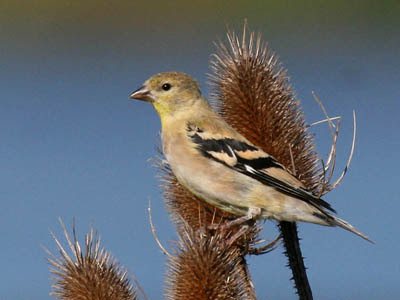 |
| American Goldfinch. Greg Gillson. |
Year-round residents across the northern half of the United States. In summer birds breed north well into Canada. In winter they move south throughout most of the U.S.
American Goldfinches are year-round residents in northern Alabama, winter visitors only in southern Alabama.
These are tiny birds with short forked black tails. Wings are black. Winter birds are dull brownish. In summer females are green while males are brilliant lemon yellow with black cap.
American Goldfinches eat black oil sunflower seeds from tube feeders. They love Niger seed from thistle feeders.
House Finch
These are one of the most widespread feeder birds in the United States.
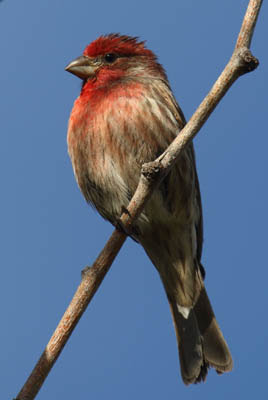 |
| House Finch. Greg Gillson. |
These birds are resident in towns throughout the United States, barely into southern Canada.
House Finches are year-round residents throughout Alabama.
Both males and females are rather dusty brown, heavily streaked on the chest. Only the males have red feathers on forehead, breast, and rump.
House Finches love to eat black oil sunflower seeds in the shell. They like tube feeders best.
White-throated Sparrow
These birds are fairly common in the East in winter, rather rare throughout the West.
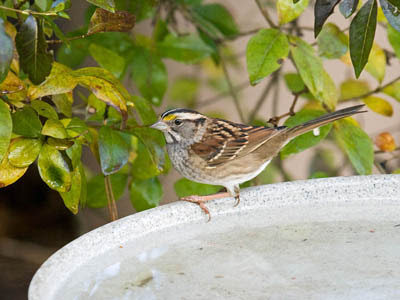 |
| White-throated Sparrow. Greg Gillson. |
These birds breed in Canada and northeastern United States. In winter they occur in the eastern and southern U.S.
White-throated Sparrows are winter visitors throughout Alabama.
These fairly large brown and gray sparrows have a striped head. The head striping can be gray and tan or black and white. The obvious white throat is bordered on the sides with throat stripes and contrasts strongly with the gray breast.
White-throated Sparrows eat smaller seeds such as white proso millet found in better mixed seed brands. They prefer to eat on the ground or platform feeders, but will also use hopper feeders.
Downy Woodpecker
This small woodpecker is widespread in North America and fairly common at bird feeders in winter.
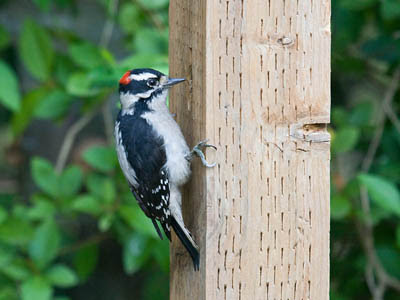 |
| Downy Woodpecker. Greg Gillson. |
Year-round residents from Alaska and across Canada south through the United States, but absent from the Desert Southwest.
Downy Woodpeckers are year-round residents throughout Alabama.
These are less than 7 inches long, bill tip to tail tip. They have a black and white striped head, white back, and black wings with white spots.
Downy Woodpeckers love suet from suet feeders. They also eat hulled sunflower seeds.
Chipping Sparrow
Look closely at your winter sparrows and you may spot these.
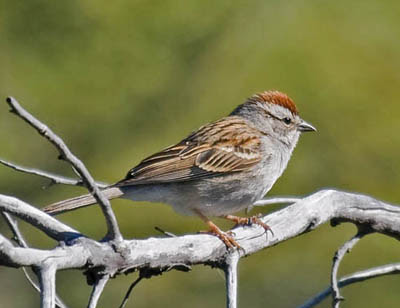 |
| Chipping Sparrow Photo by Greg Gillson |
These birds breed in orchards or scattered patches of fields and woodlands throughout Canada and most of the United States and highlands of Mexico. They winter widely across the southern United States and Mexico.
Chipping Sparrows are summer residents throughout Alabama.
These sparrows are small and slim with a longer thin forked tail. They are gray underneath, the back and wings are brown with darker streaks. The face is rather plain with a thin black line behind the eye. The chestnut crown in summer is paler and streaked with fine brown lines in winter.
In winter they give a high-pitched and rather hard seeep call.
Chipping Sparrows eat small seeds such as those found in the mixed seed blends. They eat best from the ground or on a low platform feeder, but will use a hopper feeder, too.
Eastern Towhee
These big shy sparrows hang out in the tangles and on the ground under the bushes.
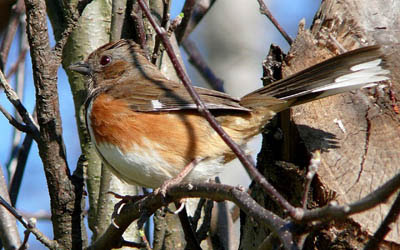 |
| Eastern Towhee. Skeeze from Pixabay. |
These birds are found in thickets and forest edges. The breed throughout the East. In winter they move to the Southeast.
Eastern Towhees are year-round residents throughout Alabama.
These are fairly large and long backyard birds. The tail is full and rounded.
These birds are blackish above, including the hooded head. The sides are rusty. The belly is white. The eye is red.
Eastern Towhees eat millet and sunflower seeds on the ground, platform, or hopper feeder.
Setting up a winter bird feeding station in Alabama
Because many of the birds at feeders in Alabama are generalist seed eaters, I would recommend to start with a hopper bird feeder and Wagner’s Songbird Supreme mixed bird seed. It is 50% sunflower seeds, and doesn’t contain any filler seed like red milo.
The birds that will love this setup include Northern Cardinals, Mourning Doves, Carolina Chickadees, Blue Jays, Tufted Titmouses, American Goldfinches, House Finches, White-throated Sparrows, Chipping Sparrows and Eastern Towhees.
The finches prefer the black oil sunflower seeds in this mix above, and the sparrows like the white proso millet.
Next, I’d set up a suet feeder. If you have trouble with flocks of starlings, or grackles, or red-winged blackbirds, or hungry jays stealing all the suet, then try out an upside-down suet feeder.
Suet will attract many different kinds of birds in winter. It will especially attract Carolina Wrens, Yellow-rumped Warblers, Downy Woodpeckers, Red-bellied Woodpeckers, Carolina Chickadees, and Blue Jays.
Just below is the article My recommended bird feeder setup with Amazon affiliate links conveniently provided to the best bird feeders and bird foods.
Wrapping Up
While winter in Alabama is milder than in many northern states, it still presents a change in scenery and challenges for the birds that flock there. Here’s a glimpse into their world:
Food:
- Fewer insects: The bustling insect buffet of summer dwindles, forcing birds to adapt. Some switch to seeds, berries, and nuts, while others venture to feeders for readily available sustenance.
- Water sources: Finding dependable water becomes crucial, especially as ponds and streams might freeze at times. Birdbaths stocked with fresh water become lifesavers for thirsty feathered friends.
Shelter:
- Dense foliage: Forests and thickets offer refuge from the occasional cold snaps and wind. Evergreens provide valuable cover and protection.
- Open fields: Some birds, like sparrows, utilize sheltered edges of fields and hedgerows to find food and escape the elements.
Frequently Asked Questions
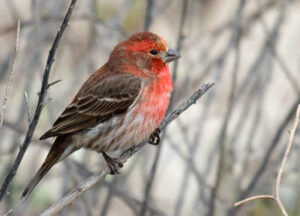
What birds migrate to Alabama in the winter?
Alabama transforms into a haven for migrating birds in winter, welcoming a diverse array of feathered friends seeking warmer temperatures and plentiful food sources. Here are some highlights of avian visitors you might encounter:
Waterfowl:
- Ducks: American Wigeon, Ring-necked Duck, Green-winged Teal, Lesser Scaup, Ruddy Duck. These ducks flock to lakes, ponds, and coastal waters, often forming large rafts.
- Geese: Snow Geese, Canada Geese. Look for them in fields, marshes, and open water, where they graze on vegetation.
Other Waterbirds:
- Loons: Red-throated Loons, Horned Grebes. These diving birds frequent the ocean and coastal bays, often seen in winter plumage.
- Gulls and Terns: Royal Terns, Forster’s Terns, Bonaparte’s Gulls. Look for them soaring and diving along the coast, catching fish and crustaceans.
Landbirds:
- Songbirds: American Pipit, Savannah Sparrow, White-throated Sparrow, Fox Sparrow. These sparrows find food and shelter in fields, grasslands, and open woodlands.
- Finches: Pine Siskin, American Goldfinch. These colorful finches flock to feeders and trees, feeding on seeds and berries.
- Raptors: Red-tailed Hawk, Northern Harrier. These predators scan fields and open areas for prey, often soaring high in the sky.
What birds migrate from Alabama in the winter?
Alabama experiences a fascinating shift in its avian population during winter as many summer residents depart and winter visitors arrive. Here are some prominent birds that migrate from Alabama in the winter:
Warblers:
- Yellow Warblers: These bright yellow songbirds head south to Central and South America.
- American Redstarts: Their flashy black and orange plumage graces southern Florida and beyond in winter.
- Hooded Warblers: Seek warmer climes in Central America and northern South America.
- Black-throated Blue Warblers: Migrate to the Caribbean and northern South America.
- Ovenbirds: Travel to the Greater Antilles and northern South America.
Tanagers:
- Scarlet Tanagers: These vibrant red birds spend winter in northern South America.
- Summer Tanagers: Migrate to Central and South America.
Other Songbirds:
- Orioles (Baltimore Orioles, Orchard Orioles): Head south to Mexico, Central America, and northern South America.
- Yellow-billed Cuckoos: Travel to South America for the winter.
- Hummingbirds (Ruby-throated Hummingbirds): Some individuals venture to southern Florida or Mexico, while others stay year-round in milder parts of Alabama.
- Vireos (White-eyed Vireos, Yellow-throated Vireos): Migrate to the Bahamas, Cuba, and Central America.
- Flycatchers (Great Crested Flycatchers, Eastern Wood-Pewees): Seek warmth in Mexico, Central America, and northern South America.
Related Articles:
The most common backyard birds in Alabama
My recommended bird feeder setup
Bird seeds that attract the most birds
Different kinds of bird feeders for different birds
Bird baths that birds actually use



